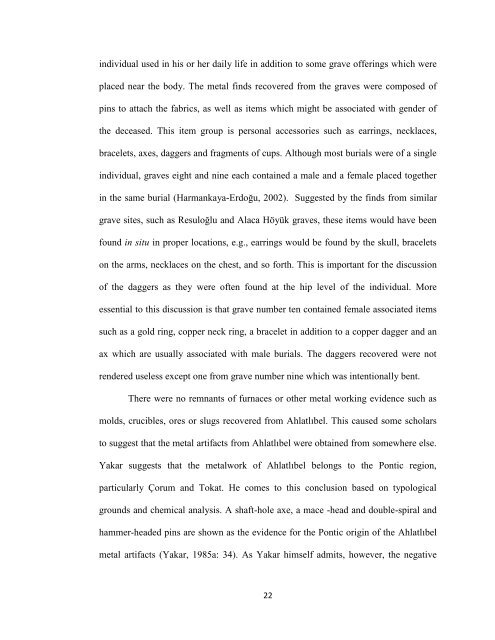EARLY BRONZE AGE DAGGERS IN CENTRAL ... - Bilkent University
EARLY BRONZE AGE DAGGERS IN CENTRAL ... - Bilkent University
EARLY BRONZE AGE DAGGERS IN CENTRAL ... - Bilkent University
You also want an ePaper? Increase the reach of your titles
YUMPU automatically turns print PDFs into web optimized ePapers that Google loves.
individual used in his or her daily life in addition to some grave offerings which were<br />
placed near the body. The metal finds recovered from the graves were composed of<br />
pins to attach the fabrics, as well as items which might be associated with gender of<br />
the deceased. This item group is personal accessories such as earrings, necklaces,<br />
bracelets, axes, daggers and fragments of cups. Although most burials were of a single<br />
individual, graves eight and nine each contained a male and a female placed together<br />
in the same burial (Harmankaya-Erdoğu, 2002). Suggested by the finds from similar<br />
grave sites, such as Resuloğlu and Alaca Höyük graves, these items would have been<br />
found in situ in proper locations, e.g., earrings would be found by the skull, bracelets<br />
on the arms, necklaces on the chest, and so forth. This is important for the discussion<br />
of the daggers as they were often found at the hip level of the individual. More<br />
essential to this discussion is that grave number ten contained female associated items<br />
such as a gold ring, copper neck ring, a bracelet in addition to a copper dagger and an<br />
ax which are usually associated with male burials. The daggers recovered were not<br />
rendered useless except one from grave number nine which was intentionally bent.<br />
There were no remnants of furnaces or other metal working evidence such as<br />
molds, crucibles, ores or slugs recovered from Ahlatlıbel. This caused some scholars<br />
to suggest that the metal artifacts from Ahlatlıbel were obtained from somewhere else.<br />
Yakar suggests that the metalwork of Ahlatlıbel belongs to the Pontic region,<br />
particularly Çorum and Tokat. He comes to this conclusion based on typological<br />
grounds and chemical analysis. A shaft-hole axe, a mace -head and double-spiral and<br />
hammer-headed pins are shown as the evidence for the Pontic origin of the Ahlatlıbel<br />
metal artifacts (Yakar, 1985a: 34). As Yakar himself admits, however, the negative<br />
22
















